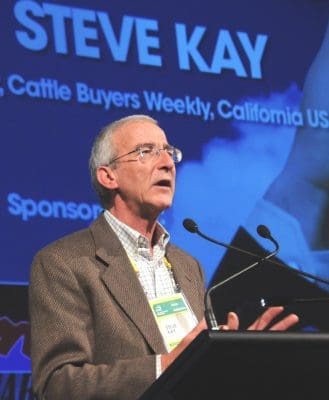 A monthly column written for Beef Central by US meat and livestock industry commentator Steve Kay, publisher of US Cattle Buyers Weekly
A monthly column written for Beef Central by US meat and livestock industry commentator Steve Kay, publisher of US Cattle Buyers Weekly
THE year of the pandemic is one that no one will ever forget. But cattle producers in the United States and Australia would surely like to erase 2020 from their memories.
A year that began with the promise of stable markets and slightly higher prices for all classes of cattle was totally upended by a virus pandemic no one could have forecast. However, the beef industries in both countries, but especially in the US, start 2021 with cautious optimism of a return to normalised markets and pricing patterns.
In this context, it is worth reminding ourselves just how devastating the COVID-19 pandemic was on the US industry. It is even more important to remember how it disrupted Americans’ and Australians’ lives, with many families having the additional heartbreak of losing a loved one to the virus, with the added pain of that loved one dying without any family members at their side.
As readers know, the disease outbreak by early March was declared a global pandemic and continued to wreak havoc on global equities and commodity markets, and on the global beef trade. Trepidation gripped the US industry throughout April as beef production levels declined to unprecedented lows relative to plant capacities because of worker illnesses and absenteeism. The last week of April saw US weekly cattle slaughter total 439,000 head, 68 percent of available slaughter capacity. The average price of live grainfed steers that week was 21pc below the same week in 2019.
Remembering how dire the challenges were is important, because what occurred in May and June was nothing short of a miracle. The many ways the US industry, from ranch to retail, tackled these challenges and returned to normalcy in such a short time is one of the greatest stories in the industry’s long history. Production levels had returned to normal levels by late June.
A return to a semblance of normality is likely this year even if the COVID-19 pandemic continues well into 2021. Everyone in the industry will be hoping that the markets will avoid the kind of extreme volatility seen last year. US packers saw record operating margins throughout last year, but cattle feeders, cow-calf operators and other cattle producers saw slim or even negative returns.
Higher cattle prices ahead
Prices for all classes of US cattle are currently forecast to be higher than last year, especially those for grainfed cattle. USDA’s 5-area steer price in 2019 averaged US$116.78 per cwt live and was expected to be around the same level last year. It was on track to achieve this in the first quarter when it averaged US$118.32 per cwt. Then the pandemic’s impact began. Second quarter prices averaged US$105.79 per cwt, third quarter prices US$101.74 and fourth quarter prices US$107.95. Annual prices averaged US$108.45 per cwt, their lowest level in many years.
Prices for US feeder (young) cattle fared a little better. The price of a medium frame No. 1 steer at Oklahoma City averaged US$142.23 per cwt in 2019. Prices last year were: first quarter US$136.42 per cwt, second quarter US$126.37, third quarter US$141.42 and fourth quarter US$137. The average for the year was US$135.30 per cwt.
USDA’s and other analysts’ forecasts for prices this year will offer hope for producers. It forecasts that its 5-area fed steer price in the first and second quarters will average US$113 per cwt and US$114 in the third quarter. Its forecast and those of five industry analysts that I surveyed last week put the 2021 annual price at US$114-117 per cwt live. This would be more than US$7 per cwt more than last year. USDA forecasts that feeder cattle prices will average US$133 per cwt in the first quarter, US$136 in the second quarter, US$141 in the third quarter and US$138 for the year.
Most forecasts are that the US national cattle herd shrunk slightly last year compared to 2019, especially on the beef side. That should pay dividends for producers as the year progresses. Drought might play a part in deciding whether beef cow liquidation picks up pace this year or not. No one of course wants to see anything approaching the exceptional drought years of 2010-2012 and their consequences. High corn prices, the main ingredient in cattle feeding rations, will also play a part in determining the price of young cattle going to feedlots.
The supply side of the industry thus will play an important role in boosting prices for all cattle producers. But ultimately, as always, domestic and global demand for US beef will determine how much cattle price improve from last year.
The biggest potential positive is that the restaurant business, especially the sector that uses high-end cuts, will be freed from COVID-19 restrictions and resume full inside dining again. Just as US cattlemen know the importance of vaccinating their calves, I hope all Americans recognise the importance of getting a COVID-19 vaccine this year, to protect themselves and their loved ones and to help the US economy recover.
